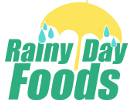"Are the cans and buckets I have in my food storage supply still good?"
This question is one our customer service representatives get asked often. Although many people have heard that food storage will last for 20 years or more, it is not entirely accurate. Some foods will have a longer shelf life than others and there are variables that will play a part in the shelf life of your food storage. We would like to provide you with some general shelf life information that may help you determine if your food storage is at a point where it should be used or rotated and replaced or it may be past the point where it would be usable.
Products stored in air tight containers (cans or buckets), unopened and in a cool, dry place will have the longest shelf life. The optimal temperature for the longest shelf life is 60 degrees F. Fluctuating temperatures (extreme highs and lows) will reduce the shelf life of the product. Once opened, most products should be used within about 6 months to a year.
Shelf life information for some genres of products are as follows:
Baking mixes, nuts, brown rice (products that may contain oils): 3 to 5 years
Dairy (shortening, butter, margarine, eggs), flax seed, imitation meats, tomato powder: 5 to 10 years
Non-fat milk, flours, hot cocoa mix: 10 to 15 years
Fruits, vegetables, buckwheat, pastas: 20 to 25 years
Grains (wheat, Ezekiel mix, oats), beans, white rice: 30+ years
Additional information for specific products can also be found with the individual product information on the website (you may have to scroll down to the details and additional information section to see this information).
You may be thinking, "This is all great information, but I don't remember when I bought my food storage. How can I tell how old it is? I can't find an expiration date on the can."
This is another familiar question and an important one. Since shelf life varies depending on the conditions in which it is stored, such as temperature or extreme heat fluctuations due to season changes, Rainy Day Foods does not put an actual "expiration" date on their cans and other packages. Instead we put the date the product was packaged. This date is in a 5 digit Julian date format that reads "dddyy". For example, a date code of 02107 would mean that it was packaged on January 21st of 2007. The days range from 001 to 365 or 366 on leap years. The Julian date can be found on the top or the bottom of the cans and is the second set of 5 digit numbers. The first set of numbers is the product code used in production.
It is also a good idea to keep in mind that as a food product ages, quality and nutrition will gradually diminish over time. Many products stored will be edible in 20 years, but they may not have the same flavor or nutrition value they would have at 10 years or less. The ideal way to use your food storage is to rotate it, using the older products and replacing them with new product - "buy what you eat and eat what you buy".
Shelf Life of Food Storage
Categories: Food Storage Tips & General Information
Tags: shelf life
Posted On: January 31 2018
Posted By: admin
Search
Recent Posts
Archives
- February 2024
- December 2023
- November 2023
- July 2023
- March 2023
- September 2022
- July 2022
- February 2022
- November 2021
- June 2021
- May 2021
- April 2021
- September 2019
- July 2019
- June 2019
- May 2019
- April 2019
- March 2019
- February 2019
- January 2019
- December 2018
- November 2018
- October 2018
- September 2018
- August 2018
- July 2018
- June 2018
- May 2018
- February 2018
- January 2018
- October 2015
- July 2015
- June 2015
- May 2015
- April 2015
- March 2015
- February 2015
- January 2015
- December 2014
- November 2014
- October 2014
- September 2014
- August 2014
- July 2014
- June 2014
- May 2014
- April 2014
- March 2014
- February 2014
- January 2014
- November 2013
- October 2013
- September 2013
- August 2013
- July 2013
- June 2013
- May 2013
- April 2013
- March 2013
- February 2013
- October 2012
- June 2012
- May 2012
- April 2012
Categories


